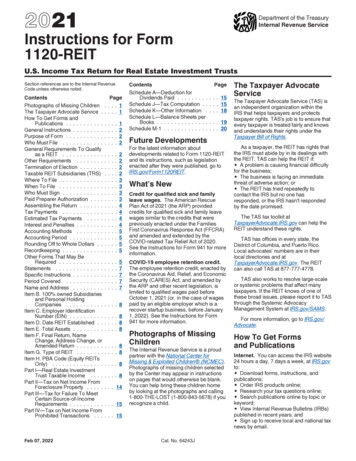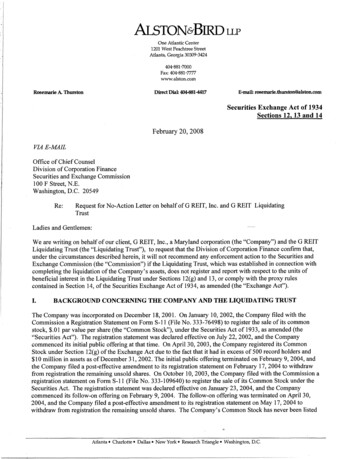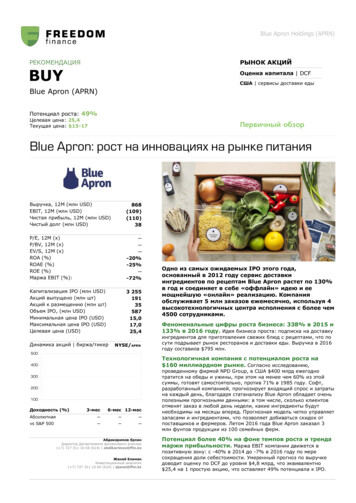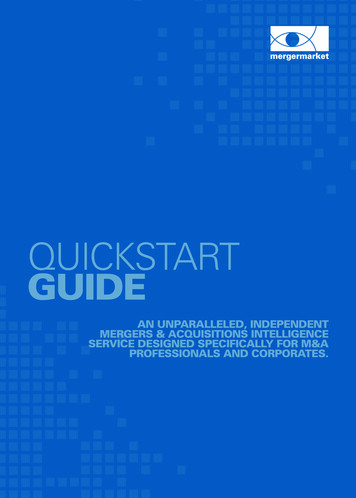
Transcription
REIT IPOsA QUICK GUIDE
REIT IPOs – A Quick GuideTABLE OF CONTENTSAN INTRODUCTION TO REITS. 1GOING PUBLIC AS A REIT . 2The Benefits of Going Public . 2PLANNING FOR AN IPO . 2Primary and Secondary Offerings . 3Governance and Board Members . 3THE OFFERING PROCESS. 3Diligence and Preparing for Filing . 4Pre-Filing Correspondence with the SEC . 4Communications Matters . 5Testing-the-Waters . 5IPO Disclosure – The Prospectus . 5Submitting the S-11 to the SEC . 7The Waiting Period . 7Responding to SEC Comments . 7Frequent Areas of SEC Comment . 8The Underwriting Agreement and the Comfort Letter. 9Marketing the Offering . 10The Post-Effective Period . 10UPREITS AND ROLL-UP. 11TAX MATTERS. 14General . 14RIDEA . 14Non-Traditional REITs . 15FINANCIAL REPORTING AND ACCOUNTING . 15Measuring Performance . 16Funds from Operations (“FFO . 16Other Performance Measures . 16SEC Treatment of Non-GAAP Financial Measures . 16Internal Control over Financial Reporting . 17Executive Compensation . 17A FINAL THOUGHT . 18ABOUT MORRISON & FOERSTER . 19ADDITIONAL REIT RESOURCES FROM MORRISON & FOERSTER LLP . 19QUICK REFERENCESSARBANES-OXLEY ACT OF 2002 . 2INTERNALLY AND EXTERNALLY MANAGED REITs . 5EMERGING GROWTH COMPANIES (“EGCs”) . 7THE MAGIC PAGE . 11CONTROLLING YOUR SHARES AND LOCK-UPS . 10THE FAST ACT . 15EXECUTIVE COMPENSATION PLANNING.17INDICATIVE IPO TIMELINE . 19IPO ACCOMMODATIONS FOR EGCs . 19THE LIKELY ALTERNATIVES . 19NYSE VS. NASDAQ: PRINCIPAL QUANTITATIVE LISTING REQUIREMENTS. 19
AN INTRODUCTION TO REITSReal estate investment trusts (“REITs”) were created in 1960 after Congress passedlegislation to provide for a new tax-advantaged method by which all types of investorscould have the opportunity to invest in a professionally managed portfolio of real estateassets. Any entity that qualifies as a REIT is entitled to special and beneficial federalincome tax treatment so long as it satisfies various requirements relating toorganization, ownership, distributions and the nature of assets and income.Over the past several years, the popularity of REITs has waxed and waned. However,fundamentals across many REIT sectors remain strong and initial public offerings(“IPOs”) of REITs remain both a key path to the realization of REIT and real estateinvestor liquidity and a potential long-term corporate finance strategy for real estatecompanies seeking to access the public capital markets.A REIT is an investment vehicle designed to allowinvestors to pool capital to invest in real estate assets.REITs have certain advantages over other investmentvehicles; in particular, a REIT is not subject tocorporate-level U.S. federal income tax on the taxableincome that it distributes to stockholders even if itsequity is publicly traded. REITs remain attractive toinvestors for this reason, despite the impact of therecently enacted tax code reform. Investors seekingcurrent income through regular distributions chooseto invest in REITs because REITs must distribute atleast 90% of their taxable income in order to maintainREIT status. REITs generally finance their activitiesthrough equity and debt offerings. Although there isan active private market for REIT securities, REITsponsors often have chosen to pursue IPOs.The industry and asset focus of REITs is diverse. Mostbroadly, there are equity REITs and mortgage REITs.Equity REITs primarily own interests in incomeproducing real property that is leased to tenants.Equity REITs typically concentrate on a marketsegment (for instance, office, retail, commercial,residential or industrial properties) or a specificindustry segment (e.g., healthcare or lodgingproperties).Mortgage REITs typically focus on originating oracquiring loans made to certain types of real estateborrowers (for instance, loans made to developers ordistressed borrowers) or on particular loan types(such as first mortgages, distressed debt or mezzaninefinancings). Although it is not unusual for REITs toinvest in multiple property types, there are relativelyfew hybrid REITs that, in the ordinary course ofexecuting their investment strategy, invest in bothoperating real property and debt instruments securedby interests in real property.2017Nine REIT IPOs raised approximately 2.9 billion of gross proceeds2018Five REIT IPOs raised approximately 3.3 billion of gross proceedsSource: Nareit Morrison & Foerster Quick Guide to REIT IPOs 1
GOING PUBLIC AS A REITREITs become public companies in the same way asnon-REITs, although REITs have additionaldisclosure obligations and may need to comply withspecific rules with respect to roll-ups, which arediscussed below.The Benefits of Going PublicThere are a variety of reasons why sponsors andmanagement teams may decide to pursue an IPO.Some of the key benefits of an IPO often include: Enhanced liquidity for owners of real estateassets; Access to the public debt and equity capitalmarkets to fund future growth; Enhancement of the company’s public profileand reputation; Greater ability to recruit and retain seniormanagement and employees; and More favorable debt financing terms thanwere achievable as a private real estatecompany.PLANNING FOR AN IPOMost companies must make legal and operationalchanges before proceeding with an IPO. A companycannot wait to see if its IPO is likely to be successfulprior to implementing most of these changes. Manycorporate governance matters (including those arisingunder the Sarbanes-Oxley Act of 2002 (“SarbanesOxley”)) and federal securities law requirements(including audited financial statements), as well asapplicable securities exchange requirements, must besatisfied when the IPO registration statement isconfidentially submitted or filed with the SEC, or thecompany must commit to satisfy them within a settime period.A company proposing to list securities on a nationalsecurities exchange should review the governancerequirements of the different exchanges, as well astheir respective financial listing requirements, beforedetermining which exchange to choose. AlthoughSarbanes-Oxley requires publicly traded companies to implementcorporate governance policies and procedures that are intended toprovide minimum structural safeguards to investors. Certain of theserequirements are phased in after the IPO, and some requirements havebeen made less burdensome for Emerging Growth Companies (EGCs)under the JOBS Act.Requirements related to the company’s internal control overfinancial reporting, including (1) management’s assessmentand report on the effectiveness of the company’s internalcontrols on an annual basis, with additional quarterly reviewobligations, and (2) audit of the company’s internal controls byits independent registered public accounting firm. However, acompany will not need to comply with the auditor attestationrequirement as long as it qualifies as an EGC.Prohibition of most loans to directors and executive officers(and equivalents thereof).Certification by the CEO and CFO of a public company of eachSEC periodic report containing financial statements.Adoption of a code of business conduct and ethics for directorsand senior executive officers.Requires “real time” reporting of certain material eventsrelating to the company’s financial condition or operations.Disclosure of whether the company has an “audit committeefinancial expert” serving on its audit committee.Disclosure of material off-balance sheet arrangements andcontractual obligations.Audit committee approval of any services provided to thecompany by its audit firm, with certain exceptions for deminimis services.Whistleblower protections for employees who come forwardwith information relating to federal securities law violations.Compensation disgorgement provisions applicable to the CEOand CFO upon a restatement of financial results attributable tomisconduct.The stock exchanges’ listing requirements contain relatedsubstantive corporate governance requirements regardingindependent directors, audit, nomination and compensationcommittees and other matters.most REITs list on the New York Stock Exchange, acompany proposing to list its securities may choose tolist elsewhere for business or other reasons. See page22 for a brief comparison of the quantitative listingrequirements of the New York Stock Exchange andNASDAQ.A company must also address other corporategovernance matters, including board and committeestructure and composition, director independence,related party transactions, and director and officerMorrison & Foerster Quick Guide to REIT IPOs 2
liability insurance. The company should undertake athorough review of its existing and contemplatedcompensation for its directors and officers as well,particularly its use of stock-based compensation. See“Executive Compensation” on page 17.Most public REITs are formed as corporations inMaryland under the Maryland General CorporationLaw (MGCL) or as under the Maryland REIT law, as aresult of Maryland’s well-developed history as a REITfocused jurisdiction. This is in contrast to otheroperating companies, which typically incorporate inDelaware if they are preparing for an IPO.Primary and Secondary OfferingsAn IPO may consist of the sale of newly issued sharesby the company (a “primary” offering), a sale of sharesowned by existing stockholders (a “secondary”offering) or a combination of both. Underwriterstypically prefer a primary offering because thecompany will retain all of the net proceeds to acquireadditional assets, to repay indebtedness or for othergeneral corporate purposes. However, some IPOsinclude the sale of secondary shares, either as part ofthe base offering or as part of the underwriters’ optionto purchase up to an additional 15% of the shares tocover overallotments. An issuer must also considerwhether any of its stockholders have registrationrights that could require the REIT to register theresale of shares held by existing stockholders, eitheras part of the IPO or thereafter, which couldpotentially put downward pressure on the share pricein the aftermarket.estate industry experience, as well as anunderstanding of risk management issues and publiccompany experience. A company should begin itssearch for suitable directors early in the IPO processeven if it will not appoint the directors until the IPO iscompleted. The company can turn to its largeinvestors as well as its counsel and underwriters forreferences regarding potential director candidates.In recent years, REITs, management teams, investors,and proxy advisory and governance firms have placeda higher priority on ensuring that REIT boards ofdirectors and management teams are diverse in termsof experience and personal background. Althoughthere is continuing debate around the benefits ofboard diversity, several studies have demonstrated apositive link between board diversity and financialperformance. Regardless of whether or not a causallink exists, the benefits of diversity of experience andbackground should be considered to ensure thatdecision-making reflects diverse perspectives. Inrecognition of the value of diversity, Nareit recentlyestablished the Dividends Through Diversity andInclusion (DDI) Initiative to promote the recruitment,inclusion and advancement of women and membersof other diverse groups in REITs and the broadercommercial real estate industry.THE OFFERING PROCESSAs described in more detail below, the IPO process isdivided into three periods: The pre-filing period between determining toproceed with an IPO and the filing of the IPOregistration statement with the SEC. During thistime, the company is in the “quiet period” andsubject to limits on public disclosures relating tothe IPO. This period typically commences whenthe lead investment banks have been mandated tolead the IPO. The waiting or pre-effective period is thetime period between the SEC filing date and thedate on which the SEC declares the IPOregistration statement “effective.” During thisperiod, the company may make oral (oralternatively written) offers but may not enter intobinding agreements to sell the offered security.Governance and Board MembersA public company must comply with significantcorporate governance requirements imposed by thefederal securities laws and the regulations of theapplicable securities exchanges, including with regardto the oversight responsibilities of the board ofdirectors and its committees. A critical matter is thecomposition of the board itself. All exchanges requirethat, except under limited circumstances, a majorityof the directors be “independent,” as defined by boththe federal securities laws and stock exchange listingrules. In addition, boards should include individualswith appropriate financial expertise and relevant realMorrison & Foerster Quick Guide to REIT IPOs 3
EMERGING GROWTH COMPANIES (“EGCs”)The JOBS Act amended the Securities Act and the Exchange Act toinclude a new type of issuer called an emerging growth company. Anissuer qualifies as an EGC if it has a total gross revenue of less than 1.07 billion (originally 1 billion, but adjusted for inflation in 2017)during its most recently completed fiscal year subject to inflationaryadjustment by the SEC every five years. An issuer will not be able toqualify as an EGC if it first sold its common stock in an SEC-registeredoffering before December 8, 2011.A company that elects to file as an EGC can benefit from the followingreduced disclosure obligations: Disclosure of only two years of audited financials (instead ofthree); No requirement to include financial information in selectedfinancial data or in Management’s Discussion and Analysisof Financial Condition and Results of Operations (“MD&A”)disclosure for periods before those required to be presentedin the IPO prospectus; Option to rely on certain scaled disclosures available tosmaller reporting companies (such as for executivecompensation); Ability to “test the waters” with Qualified Institutional Buyers(QIBs) and institutional accredited investors to gaugeinterest before or after filing (See “The Pre-Filing Period”below); Exemptions from:o Advisory stockholder votes on executive compensation(“say-on-pay”) and golden parachute payments;o Disclosing the relationship between executivecompensation and financial performance;o Disclosing CEO pay-ratio;o Auditor attestation of internal controls under Section404 of Sarbanes-Oxley; ando Compliance with new or revised accounting standardsuntil the date the standard becomes broadly applicableto private companies.An issuer will remain an EGC until the earliest of: The last day of the first fiscal year after the issuer’s annualrevenues exceed 1.07 billion; The last day of the fiscal year following the fifth anniversaryof the issuer’s IPO;The post-effective period is the time periodbetween effectiveness of the IPO registrationstatement and the 25th day after effectiveness.During this period, the underwriters may sell thesecurities by delivering the prospectus containedin the IPO registration statement or a notice withrespect to its availability.Diligence and Preparing for FilingA company should keep in mind that underwritershave at least two conflicting responsibilities—to sellthe IPO shares on behalf of the company and torecommend to potential investors that the purchase ofthe IPO shares is a suitable and worthy investment.In order to better understand the company—and toprovide a defense in case the underwriters are sued inconnection with the IPO—the underwriters and theircounsel typically spend a substantial amount of timeperforming business, financial and legal due diligencein connection with the IPO.During the pre-filing period, key managementpersonnel will generally make a series ofpresentations to the underwriters covering thecompany’s business and industry, marketopportunities and financial performance. Theunderwriters typically will use these presentations asan opportunity to ask questions and establish a basisfor their “due diligence” defense. In particular,underwriters will want to visit the most significantproperties owned by equity REITs as well as analyzethe mortgage loan portfolios of mortgage REITs.Furthermore, it is important that any material itemsidentified during the due diligence process areappropriately reflected in the IPO prospectus toensure that there are no material misstatements oromissions in the disclosure. From the first all-handsorganizational meeting forward, all statementsconcerning the company should be reviewed by thecompany’s counsel to ensure compliance withapplicable rules.Pre-Filing Correspondence with the SECREIT formation transactions can be complex,resulting in significant accounting and financialreporting issues. The SEC is available to discuss theseaccounting and structuring issues even in advance of aconfidential submission or public filing of aregistration statement, and it is advisable to approachthe SEC early in the process to avoid costly delays.See “Financial Reporting and Accounting” below.Morrison & Foerster Quick Guide to REIT IPOs 4
Communications MattersCommunications by an issuer more than 30 days priorto the date on which the registration statement ispublicly filed are permitted as long as they do notreference the securities offering. Statements madewithin 30 days of filing a registration statement thatcould be considered an attempt to condition themarket or pre-sell the IPO may be considered anillegal prospectus, creating a “gun jumping” violation,which may result in the SEC delaying the IPO orrequiring disclosure in the prospectus regarding thesepotential securities law violations. Press interviews,participation in investment banker-sponsoredconferences and new advertising campaigns aregenerally discouraged during this period.Testing-the-WatersThe JOBS Act has softened the gun-jumping fears. Ifthe company is an EGC under the JOBS Act, it canengage in test-the-waters communications withcertain sophisticated investors referred to as QIBs andinstitutional accredited investors to gauge interest inthe IPO during both the pre-filing period and afterfiling without being required to file writtenINTERNALLY AND EXTERNALLYMANAGED REITsA REIT can be either internally or externally managed. Ina REIT with an internal management structure, theREIT’s own officers and employees manage theportfolio of assets. In a REIT with an internalmanagement structure, the REIT’s own officers andemployees manage the portfolio of assets. A REIT withan external management structure usually resembles aprivate equity style arrangement, in which the externalmanager receives a base fee and an incentive fee formanaging the REIT’s portfolio of assets.An external manager will typically receive a basemanagement fee and an incentive fee. The basemanagement fee is often based on a percentage ofstockholders’ equity or the value of assets undermanagement, while the incentive fee is often based onthe achievement of targeted levels of earningscalculated based on GAAP or non-GAAP measures.communications with the SEC. However, the SEC willask to review copies of any written materials used forthis purpose. Current market practice has been to usetest-the-waters communications, which usually takeplace after the first confidential submission of aregistration statement. An issuer should consult withits counsel and the underwriters before engaging inany test-the-waters communications.In February 2019, the SEC voted to propose anexpansion of the test-the-waters accommodations thatwould allow all issuers (including non-EGCs) to gaugemarket interest in a proposed registered securitiesoffering, including an IPO, by permitting discussionswith QIBs and institutional accredited investors priorto the filing of a registration statement. As of the dateof this IPO Guide, the proposed rules have not beenadopted.IPO Disclosure – The ProspectusThe prospectus describes the offering terms, theanticipated use of proceeds, the company, its industry,business (including competitive strengths and growthstrategies), management and ownership, and itsresults of operations and financial condition.Although it is principally a disclosure document, theprospectus is also crucial to the marketing and saleprocess. A good prospectus sets forth a compellinginvestment proposition.As a disclosure document, the prospectus functions asan “insurance policy” of sorts in that it is intended tolimit the issuer’s and underwriters’ potential liabilityto IPO purchasers. If the prospectus contains all SECrequired information, includes robust risk factors thatexplain the risks and uncertainties that the companyfaces, and has no material misstatements oromissions, it will be challenging for investors torecover their losses in a lawsuit if the price of the stockdrops following the IPO.A prospectus should not include “puffery” or overlyoptimistic or unsupported statements about thecompany’s future performance. Rather, it shouldcontain a balanced discussion of the company’sbusiness, along with a detailed discussion of risks,operating and financial trends, and materialuncertainties that may affect its financial condition,results of operations and prospects.Morrison & Foerster Quick Guide to REIT IPOs 5
SEC rules set forth specific disclosures to be made in aprospectus for a public offering of securities as well asfor ongoing disclosures once the issuer is public. Thegeneral form for an IPO by a U.S. domestic entity isForm S-1. Real estate companies, such as REITs,however, are instead required to use Form S-11. Inaddition to the same kinds of disclosures required byForm S-1, Form S-11 sets forth the followingdisclosure requirements: Investment policies with respect to investments,mortgages and other interests in real estate in lightof the issuer’s prior experience in real estate; Location, general character and other materialinformation regarding all material real propertiesheld or intended to be acquired by or leased to theissuer or its subsidiaries; for this purpose,“material” means any property which has a bookvalue of 10% or more of the total assets of theconsolidated issuer or the gross revenues fromwhich are at least 10% of the aggregate grossrevenues of the consolidated issuer for the lastfiscal year; Operating data of each improved property, such asoccupancy rates, number of tenants, and principalprovisions of the leases; and Arrangements with respect to the management ofthe issuer’s real estate and its purchase and sale ofmortgages.Furthermore, and in contrast to the generalrequirements of Form S-1, Form S-11 and IndustryGuide 5 contain detailed requirements regarding realestate ownership, investment policies, operating data,descriptions of real estate assets and, with respect toblind pool REITs, disclosures about the priorperformance of sponsors and their affiliates.Blind pool REITs, which are REITs that do not ownassets and do not identify specific real properties orreal-estate related debt instruments to be acquiredwith the net proceeds from the potential IPO (with theproperties or loans being determined after the closingof the IPO in accordance with a predeterminedinvestment strategy), are also subject to the SEC’sIndustry Guide 5, which sets forth the followingadditional disclosure requirements: Risks relating to: (i) management’s lack ofexperience or lack of success in real estateinvestments; (ii) uncertainty if a material portionof the offering proceeds is not committed tospecified properties; and (iii) real estate limitedpartnership offerings in general; General partner’s or sponsor’s prior experience inreal estate; and Risks associated with specified properties, such ascompetitive factors, environmental regulation, rentcontrol regulation, and fuel or energy requirementsand regulations.Depending on the nature of the specific REIT—UPREIT, DownREIT (a partnership agreementbetween a property owner and REIT), equity,mortgage, externally managed, internally managed, orinternally administered blind pool, etc.—there areadditional necessary disclosures. In July 2013, theSEC issued guidance regarding disclosure by nontraded REITs, particularly the applicability of certainprovisions of Industry Guide 5, which may also beinstructive for REITs that intend to list on a nationalsecurities exchange. 1 If the transaction meets the SECdefinition of a “roll-up transaction,” there areadditional disclosure obligations (see “UPREITs andRoll-Ups” on pages 2 and 3).In addition, the federal securities laws, particularlyRule 10b-5 under the Exchange Act, require thatdocuments used to sell a security contain all of theinformation material to an investment decision anddo not omit any information necessary to avoidmisleading potential investors. Federal securities lawsdo not define materiality; the basic standard fordetermining whether information is material iswhether a reasonable investor would consider theparticular information important when making aninvestment decision. That simple statement is oftendifficult to apply in practice.Most new REITs will qualify, however, as EGCs andcan take advantage of the scaled disclosurerequirements available for smaller public reporting1 CF Disclosure Guidance: Topic no. 6, “Staff Observations Regarding Disclosures of NonTraded Real Estate Investment Trusts” (July 16, 2013), available guidance-topic6.htm.Morrison & Foerster Quick Guide to REIT IPOs 6
companies (see “Emerging Growth Companies” onpage 6). Regardless of EGC status, however, an issuershould be prepared for a time-consuming draftingprocess, during which the issuer, investment bankersand their respective legal counsel work together tocraft the prospectus disclosure.Submitting Form S-11 to the SECWhile there is no prescribed time period, typicallyfour to six weeks will pass between the distribution ofa first draft of the registration statement to theworking group and its filing with, or confidentialsubmission to, the SEC. To a large extent, the lengthof the pre-filing period will be determined by theamount of time that is necessary to prepare therequired financial statements.An issuer may confidentially submit a draftregistration statement for non-public review but mustpublicly file (referred to as “going live” on the filing)its
the IPO. This period typically commences when the lead investment banks have been mandated to lead the IPO. The waiting or pre-effective period . is the time period between the SEC filing date and the date on which the SEC declares the IPO registration statement "effective." During this period, the company may make oral (or










